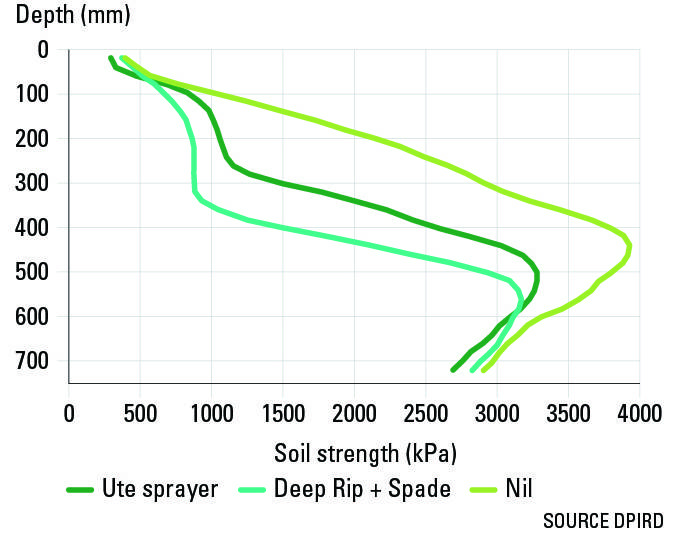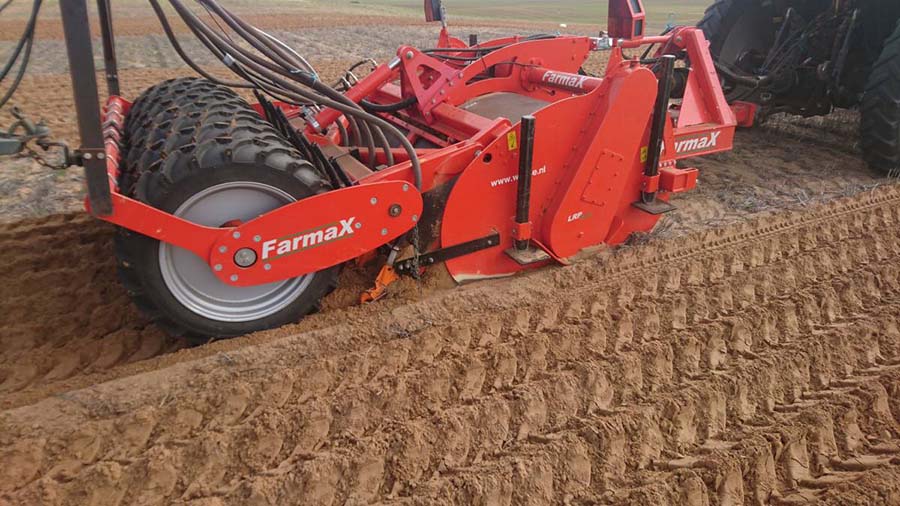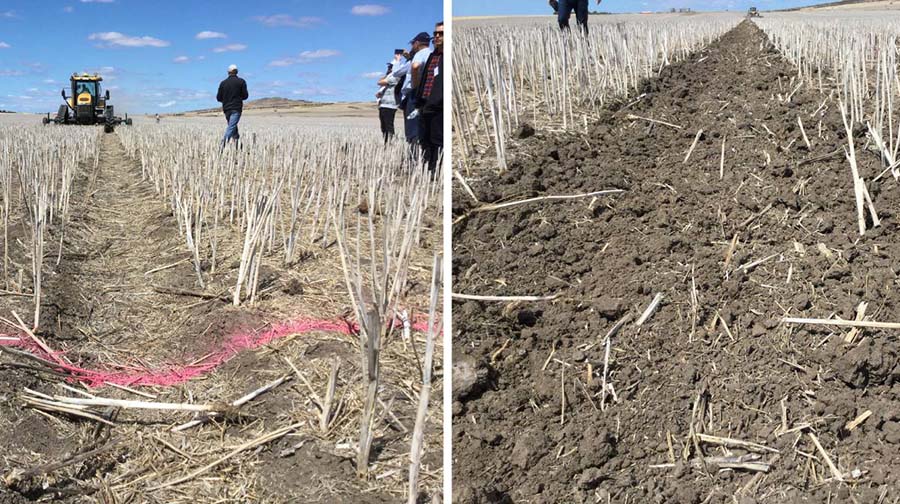Key points
- Strategic deep tillage can alter soil structure and surface conditions but the risk of re-compaction still poses crop establishment challenges.
- Adopting controlled traffic can reduce the risk of re-compaction. Rollers can improve seed beds and aid trafficability, while various seed strategies including alterations to seeding bars and broadcast seeding can aid crop establishment in ameliorated soils.
As strategic deep tillage amelioration techniques alter the soil structure and surface conditions, planning for the soil's post-treatment management must start prior to these techniques being used.
Deep soil mixing, inversion ploughing and deep ripping leave a very 'soft' soil highly susceptible to re-compaction with consequent challenges for crop establishment.
Re-compaction
Substantial damage can be done to the soil in the first machinery pass after amelioration.
For example, penetrometer measurements from a ripped and spaded deep yellow sand show considerable re-compaction after just one pass of a ute-mounted trial boomspray weighing about 3.1 tonnes (see Figure 1).
Figure 1: Soil strength profiles from a deep yellow sand that has been deep-ripped and spaded, showing re-compaction from one pass of a ute-mounted trial boomspray.

Source: DPIRD
At 260-millimetre depth, the soil has returned to 50 per cent of the strength it was prior to amelioration; at 340mm the soil is at 68 per cent of the strength it was prior to amelioration. This re-compaction is even greater with heavier equipment.
To minimise the area trafficked post-amelioration and to increase the longevity of uncompacted soil conditions, consider matching machinery operating widths and wheel track widths through controlled-traffic farming (CTF).
This will reduce the trafficked area, as a standard no-till system 'wheels' about 40 per cent of the paddock compared with a fully matched CTF system that wheels 11 per cent of the paddock.
Seedbed preparation
Trafficability for seeding, spraying and other paddock management operations must be considered before implementing strategic deep tillage.
Towing a weighted roller behind the machinery helps produce a firmer, more even seedbed, breaking up any soil clods often produced when ripping heavier soil types.
However, smooth soil surfaces, if dry and left unsown for a time, are prone to wind erosion. Truck tyre rollers, steel drum rollers with water ballast, large-diameter steel pipe, cage rollers and coil packers all achieve soil levelling, although the particular finish is specific to soil type and amount of movement required.
Clod-breaker rollers incorporate 75 to 90mm-high tooth racks that can break up cloddy soil and more effectively prepare soil conditions for seeding.
Many farmers have reported topsoil inclusion plates leaving large furrows in moist soil. If these furrows can't be levelled using a roller at the time of ripping, then it is advisable to take the plates off or incorporate ridge-divider tynes to help achieve a more level finish after rolling.
When deep ripping, rollers further reduce the amount of standing stubble, so it is important to understand your erosion risk, particularly in sandy soils.
Wind erosion risk is reduced when 50 per cent stubble or plant cover is retained at the beginning of autumn. In sandy-surface soils with high erosion risk, deeper ripping and topsoil slotting leaves significantly more residue cover compared with the complete stubble burial from soil inversion and deep soil mixing. Where stubble cover is too low, some growers will choose not to deep rip to avoid the risk of erosion.
Crop establishment
Managing seeding depth is difficult if the seeding bar has not been adjusted or modified for deep, soft soil.

(Figure 3) A modified research spader in South Australia uses conventional Suffolk openers and a tow-behind mini air-cart to achieve one-pass spade and sow amelioration. Photo: UniSA
Reducing the weight of the bar, locking castor wheels, half-filling the air-cart tanks, increasing tyre width and lowering tyre pressure for flotation, or using a specialised lightweight seeding system with wheel regulated seed boots, are all practical adjustments that are currently being used to control where seed is sown.
The following strategies have been found to help with crop seeding into soft soils:
- Ground-following seeding equipment. Controlling the operating depth of each row with a press wheel-based mechanism where the targeted seeding depth is maintained 'on the go'.
- Wider press wheels. Reduce bar sinkage and reduce a bulldozing effect where bar weight is partially carried on press wheels. Shallow press wheel furrows and stable side furrow slopes are critical to minimise risks and impact of wind-induced backfilling.
- Light seeding bars. When there are large areas of deep ripping or soil amelioration is to take place, adapting flexible trailing seeding boots on seeders is better able to maintain a shallow sowing depth and assist consistent crop establishment.
- Shallow working seeding points with seed delivery to the bottom of the furrow can help minimise soil throw and even sowing depth, especially at narrow row spacings. Worn or cut-off knife points with single-shoot banding boots are also an option. This approach should best be combined with contour-following technology.
- Broadcast seed spreading. In the first year of amelioration, broadcast spreading of cereal seed on to wet soil, pressed down with coil packers, press wheels or truck tyre roller.
- Cross-seeding deep-ripped paddocks. Grower experience has shown seeding offset to the main working direction improves plant establishment outcomes. Seeding at 45 degrees to subsequent spraying and harvest nearly doubles the trafficked area of the paddock, negating long-term return from the soil-loosening investment. Before cross-seeding, consider why this option is needed. Is it overcoming water repellence, high stubble load, maintaining depth control, or reducing bogging caused by seeder design? There are options to avoid cross-seeding, such as managing for repellence or modifying seeder set-up.
- Undertaking deep tillage when the soil is wet and immediately seeding into moist soil - including one pass 'till and sow' (see Figure 3) scenarios - can improve establishment outcomes and minimise erosion risk. One pass 'spade and sow' and 'plough and sow' operations have successfully been pioneered by integrating seeding systems within a spader with a tractor-mounted or tow-behind air-cart, or with a combine drill pulled behind a plough.
Be aware of the implications of bringing up excessive clay when deep mixing, inverting or delving. Increased clay percentage at the surface, with little organic matter, increases the risk of surface crusting.
In addition, sealed clay at the surface also encourages shallow water loss to evaporation. These two effects can reduce establishment of shallow-sown, small-seeded crops.
Herbicide activity is increased after soil inversion and deep mixing as organic matter and water repellence in the surface is reduced. This benefits weed control, but also increases the risk of crop damage.
Soil active pre-emergent herbicides Diuron®, trifluralin, Boxer Gold® and Sakura® have all shown various levels of damage to plant emergence numbers in wheat and barley in soil with low organic matter.

(Figure 4) Wheel ruts in wheel track before renovation; note canola stalk indicating surface level (left) and wheel ruts filled with spoil and firmed after wheel track renovation (right). Photo: DPIRD
Avoiding crop damage requires careful selection and judicious use of pre-emergent herbicide options but, depending on the amelioration method used, post-emergent options are often sufficient.
Ruts formed on wheel tracks from initial machinery passes on soft soil can reduce emergence in systems that don't have independent seeding row depth control.
Rows on the edge of the wheel tracks can be sown too deeply while those in the tracks are sown too shallow.
Low emergence in the wheel tracks may pose a threat of erosion during the season. Maintaining the wheel tracks through soil in-filling levels the soil surface and can improve establishment.
There are numerous commercially available wheel track renovators that cut at the edges of the rut, drag soil into the rut and press it firm. A renovated wheel track should be level, firm and with some stubble to improve structure (see Figure 4).
More information: Wayne Parker, DPIRD, 08 99568511, wayne.parker@dpird.wa.gov.au

























































